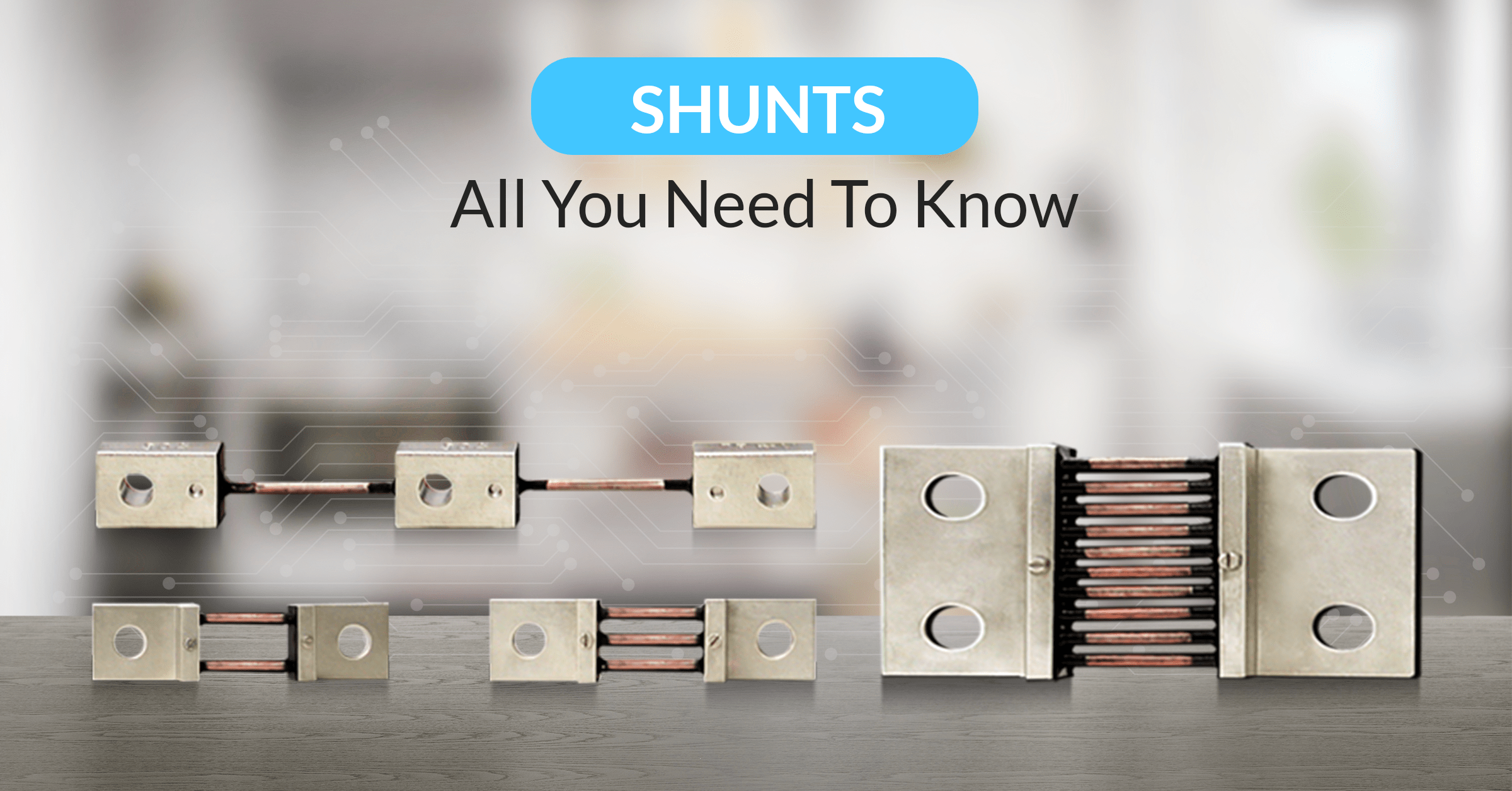In this blog, we are going to understand in detail what are shunts, how ammeter shunts work, their uses, types, and much more.
A shunt (or shunt resistor) is a device that creates a low resistance path for an electric current, to allow it to pass through another point in the circuit. Shunts are also referred to as current shunt resistors, ammeter shunts, current shunts, or DC shunts. They are used for both direct and alternating current measurements.
A shunt resistor, often called a dc ammeter shunt when used with direct current measuring devices, always has a very low resistance because it is made of a material having a low-temperature coefficient of resistance.
Working principle of shunts
Shunts are designed with an extremely low resistance value. When current flows through them, they create a small voltage drop. This drop is proportional to the current passing through the shunt. This voltage drop is then used to measure the current accurately.
- Current Flow: When current passes through the main circuit, a fraction of it flows through the shunt due to its low resistance.
- Voltage Drop Creation: As current journeys through the shunt’s low-resistance path, a tiny voltage drop is generated.
- Voltage Measurement: By measuring this voltage drop across the shunt, we can determine the current flowing through the main circuit.
- Precise Current Calculation: We apply Ohm’s law (Current = Voltage / Resistance) to accurately calculate the current.
At BEEMET, we grasp the significance of shunts in current measurement accuracy. Our shunts are carefully designed to ensure dependable and precise operations.
Key factors to consider when choosing a Shunt
Shunts are designed with an extremely low resistance value. When current flows through them, they create a small voltage drop. This drop is proportional to the current passing through the shunt. This voltage drop is then used to measure the current accurately.
- Current Flow: When current passes through the main circuit, a fraction of it flows through the shunt due to its low resistance.
- Voltage Drop Creation: As current journeys through the shunt’s low-resistance path, a tiny voltage drop is generated.
- Voltage Measurement: By measuring this voltage drop across the shunt, we can determine the current flowing through the main circuit.
- Precise Current Calculation: We apply Ohm’s law (Current = Voltage / Resistance) to accurately calculate the current.
At BEEMET, we grasp the significance of shunts in current measurement accuracy. Our shunts are carefully designed to ensure dependable and precise operations.
How to Measure Current Using Shunt?
Many ammeters have built-in resistors to measure the current. However, a shunt in ammeter circuits is necessary when the range of current to be measured exceeds a certain value, say 30A, and a different circuit is required.
In this circuit, an ammeter is placed in parallel with a shunt resistor. These are known as DC ammeter shunts, designed specifically for measuring high DC currents. This shunt has a very low resistor value to prevent heat generation and loss of power.
The current gets divided between the shunt resistor and ammeter in such a way that only a small percentage flows through the ammeter. A large amount of current bypasses the ammeter and flows through the shunt resistor. This current generates a voltage drop. The resulting voltage drop will correspond directly to the current passing through the circuit.
Using Ohm’s law, I = V/R, you can measure the current.
Position of the Shunt Within the Circuit
It is important to take precautions with respect to the positioning of the shunt within the circuit. The ammeter shunt should be placed as close to the ground as possible. This helps in protecting the ammeter against common-mode voltage that can be too high and may damage the device.
A shunt can also be isolated from the ground by placing it on an ungrounded leg. A voltage divider or an isolation amplifier can be included in this type of circuit.
How to Build a Shunt Resistor?
A thin copper wire can be used to design a shunt resistor. However, the size and length of the shunt depend on the resistance you need. The resistance of the shunt resistor used depends on the current range to be measured by the ammeter.
If you use 10 AWG copper wire having a diameter of 2.59mm, the resistance of the wire per 1000 feet is 0.9989 ohms. The resistance varies as per the diameter of the wire.
To calculate the length of the wire for a particular value of the shunt resistor, you can use the shunt resistor formula mentioned below:
Length of the wire = Reqd shunt resistance / Resistance per 1000 feet.
If you are looking for shunts for industrial use, you can get in touch with us. Beemet is one of the leading ammeter shunts manufacturers. We supply electrical measuring instruments to companies around the world.
Types of Shunt Resistors
Based on the material used to make them, shunt resistors are classified into 4 types:
- Carbon Shunt Resistor – A carbon shunt resistor is designed using finely ground insulating and carbon material.
- Metal alloy shunt resistors are made using two or more metallic elements. For example, Manganin – an alloy of copper, manganese and nickel is widely used in metal alloy shunts.
- Wire-wound resistors are designed using conductive wire and are wound on a ceramic rod.
- Ceramic shunt resistors are made of solid, resistive, high-temperature ceramic materials with metal contacts.
Based on functions, here are a few other types of shunt resistors:
DC Current Shunt Resistor
This DC shunt resistor is used to measure high current. It transmits a millivolt output to measuring instruments that are in proportion to the flow of current. It is usually connected in series with a heater, DC motor, and battery charger.
High Power Shunt Resistor
A metal alloy is soldered to copper terminals to create a high-power shunt resistor. High power shunts have an array of industrial applications. These shunts are used in voltage division, frequency converters, current sensing in hybrid and electric vehicles, bus bars and battery management services.
High Power Low Ohmic Shunt Resistor
In automotive systems and industrial equipment, this shunt resistor is used for current detection.
Applications of Shunt Resistor
Here are a few applications of shunts:- A shunt resistor is one of the prominent devices used in an overload protection circuit.
- It is used in a circuit to protect against overvoltage.
- A shunt resistor along with a capacitor in the circuit is used to prevent the problem of high-frequency noise.
- A shunt also monitors the power and measures the current flowing through the battery.
Advantages of Ammeter Shunts Resistors
- Shunts are used for both DC and AC measurements.
- It is easy to measure the high current flowing through a circuit using the shunt resistor.
- Shunts are shock and vibration-proof devices.
FAQs
It is connected with an ammeter to bypass the current. It creates a low resistance path in the circuit and allows the current to flow through another path.
Yes. A shunt resistor generates heat as the current passes through it.
Shunt resistors are made of a variety of materials like carbon film, ceramic, metal film, metal oxide, metal alloy, wire-wound, thick film and thin film.



